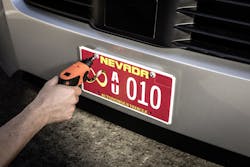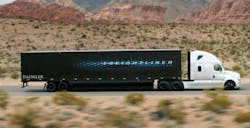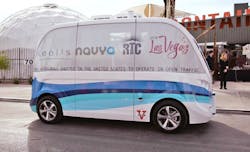April Sanborn was part of the Nevada Department of Motor Vehicles in 2011 when the state became the first to adopt regulations allowing the testing of autonomous vehicles.
She was also there four years later when the Freightliner Inspiration truck made its world premiere at the Hoover Dam.
Sanborn, now Nevada DMV’s program manager for the autonomous vehicle program, said the rapid developments in the autonomous space has her convinced autonomous-driving trucks will soon be a reality.
“I honestly see it a lot quicker than 2025,” she said of the deployment of autonomous-driving and platooning trucks. “We are a couple years away.”
It is a timetable that Thomas Martin, autonomous vehicle management analyst with Nevada DMV, completely agrees with.
“It is definitely closer than further out,” Thomas said of some autonomous and platooning trucks hitting the road in limited, but real world, applications.
During a recent telephone interview with Fleet Owner, Sanborn said Nevada is pushing forward with additional legislation to further encourage the testing and deployment of autonomous vehicles within the state’s borders.
She also was skeptical the federal government is able to keep up with the pace of the technology.
While she hopes there will one day be federal regulations, no one should expect them to be finalized anytime soon.
“We’re continuing to move forward,” Sanborn said. “We cannot wait for the federal government to make any kind of laws or mandates.”
She suggested if enough states were able to get clear standards in place, the federal government could then “take that model and move forward.”
In late July, the House Energy and Commerce Committee sent legislation to the full House that would allow companies to more easily test self-driving cars. The pending federal legislation does not include trucks.
Nevada’s Sanborn acknowledged the state did not consider commercial trucking applications in 2011 when it became the first to pave the way for driverless vehicle testing.
In fact, she said the initial response was “an automatic no” when Daimler Trucks North America inquired about testing driverless trucks.
It was not until after Daimler’s “mind-blowing” presentation that Nevada quickly came to realize “the commercial industry would catapult way ahead of the consumer portion,” Sanborn said.
Nevada has long been at the forefront of this movement, even beyond the Freightliner Inspiration event.
Last year, Sam Schmidt, a paralyzed former racecar driver, became the first person in the United States to receive a restricted driver’s license for a semi-autonomous vehicle in Nevada. Several months later the state also tested the first completely autonomous, fully electric shuttle to ever be deployed on a public roadway.
Despite these accomplishments, many states have responded with their own aggressive steps to attract companies for autonomous testing.
It has created a growing business competition among states, although they also need to work together to develop reciprocal agreements to make is easier for manufacturers to work across state lines, Sanborn stressed.
Nevada is working to reclaim its position as a leading state for autonomous development with a new law signed by Gov. Brian Sandoval (R) in June. It allows for testing and operations of fully autonomous vehicles, the commercial use of fully autonomous vehicles and testing and operations of platooning technologies.
“The idea is to encourage business to come to Nevada to test and deploy in our state,” she said. “We don’t want to stifle any of that technology.”
Sanborn noted Nevada’s autonomous and platooning regulations would dissipate if federal laws or regulations were ever formalized.
For states waiting on action from the federal government, Sanborn encouraged them not to take a “back-seat approach.”
Additionally, she said unless state laws explicitly prohibit autonomous or platooning testing, they can be sure some companies are doing it within their borders.
“It is best to get ahead on it to protect their residents,” she said.
Thomas noted Nevada issued several more licenses during 2017 for autonomous and platooning related to on-road testing.
There are also more and more companies retrofitting their own vehicles with autonomous technologies and testing them on roadways far away from the spotlight of some of the high-profile events the public has seen.
Even with their bullish outlook on autonomous trucks, the Nevada officials stress truck drivers should not be worry about their jobs in the near term.
While a younger person thinking of becoming a truck driver “may want to look elsewhere,” Sanborn added it will be “many years to come before we remove the driver."
About the Author
Neil Abt
Neil Abt is a former FleetOwner editor who wrote for the publication from 2017 to 2020. He was editorial director from 2018 to 2020.




